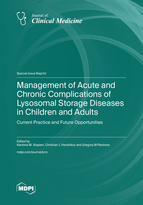Management of Acute and Chronic Complications of Lysosomal Storage Diseases in Children and Adults: Current Practice and Future Opportunities
A special issue of Journal of Clinical Medicine (ISSN 2077-0383). This special issue belongs to the section "Clinical Neurology".
Deadline for manuscript submissions: closed (31 May 2022) | Viewed by 45670
Special Issue Editors
Interests: lysosomal storage diseases; mucopolysaccharidosis; cardiovascular risk; fucosidosis; mucolipidosis I, II, III and IV; secondary mitochondrial dysfunction; transition process; GM1 gangliosidosis; hematopoietic stem cell transplantation; hormonal dysfunction
Special Issues, Collections and Topics in MDPI journals
Interests: lysosomal storage diseases; mucopolysaccharidosis; morquio syndrome; enzyme replacement therapy; neurodegeneration; niemann pick c; alpha-mannosidosis; pompe disease; transition process; wearable technology; neuronal ceroid lipofuscinosis; lysosomal acid lipase deficiency
Interests: gaucher disease; fabry disease; metachromatic leukodystrophy; krabbe disease; niemann pick disease; farber disease; GM2 gangliosidosis; clinical genetics; neurogenetics; genetic counselling; therapeutic options; biomarkers; neuropathophysiology
Special Issue Information
Dear Colleagues,
Lysosomal Storage Diseases (LSDs) consist of a group of more than 70 inherited metabolic conditions caused by defects in genes that encode proteins involved in lysosomal homeostasis.
The diseases manifest with clinical symptoms in childhood, although attenuated forms may present for the first time with subtle symptoms in adolescence or adulthood. The spectrum of clinical symptoms varies but the clear genotype–phenotype correlation is not well described for many of these conditions. Intrafamilial heterogeneity has been commonly observed but is not well understood.
Earlier diagnosis and advances in treatment have much improved the prognosis and life expectancy of patients with LSDs over the last decades, meaning that more than 90% of these patients will survive beyond the age of 20 years. The increased survival has created a number of new issues and challenges: the development of long-term age-related complications, the metabolic progression of the underlying LSD, and the lack of data on the natural history of the disease. These new challenges require the care of adolescent LSD patients being transferred from metabolic paediatricians to metabolic physicians specialised in treating adults to an increasing extent, including the development and coordination of a multidisciplinary team for each individual LSD in tertiary centres.
This Special Issue of the Journal of Clinical Medicine aims to attract original research articles, reviews, and short communications on understanding recent advances in diagnosing and managing acute and chronic complications of LSDs.
Dr. Karolina M. Stepien
Prof. Christian J. Hendriksz
Prof. Gregory Pastores
Guest Editors
Manuscript Submission Information
Manuscripts should be submitted online at www.mdpi.com by registering and logging in to this website. Once you are registered, click here to go to the submission form. Manuscripts can be submitted until the deadline. All submissions that pass pre-check are peer-reviewed. Accepted papers will be published continuously in the journal (as soon as accepted) and will be listed together on the special issue website. Research articles, review articles as well as short communications are invited. For planned papers, a title and short abstract (about 100 words) can be sent to the Editorial Office for announcement on this website.
Submitted manuscripts should not have been published previously, nor be under consideration for publication elsewhere (except conference proceedings papers). All manuscripts are thoroughly refereed through a single-blind peer-review process. A guide for authors and other relevant information for submission of manuscripts is available on the Instructions for Authors page. Journal of Clinical Medicine is an international peer-reviewed open access semimonthly journal published by MDPI.
Please visit the Instructions for Authors page before submitting a manuscript. The Article Processing Charge (APC) for publication in this open access journal is 2600 CHF (Swiss Francs). Submitted papers should be well formatted and use good English. Authors may use MDPI's English editing service prior to publication or during author revisions.
Keywords
- COVID-19
- adult-onset
- neurocognitive dysfunction
- airways management
- cardiovascular risk
- pain management
- dysostosis multiplex
- pregnancy
- hematopoietic stem cell transplantation
- gene therapy
- adverse reactions
- molecular chaperones
- transition to adult services







